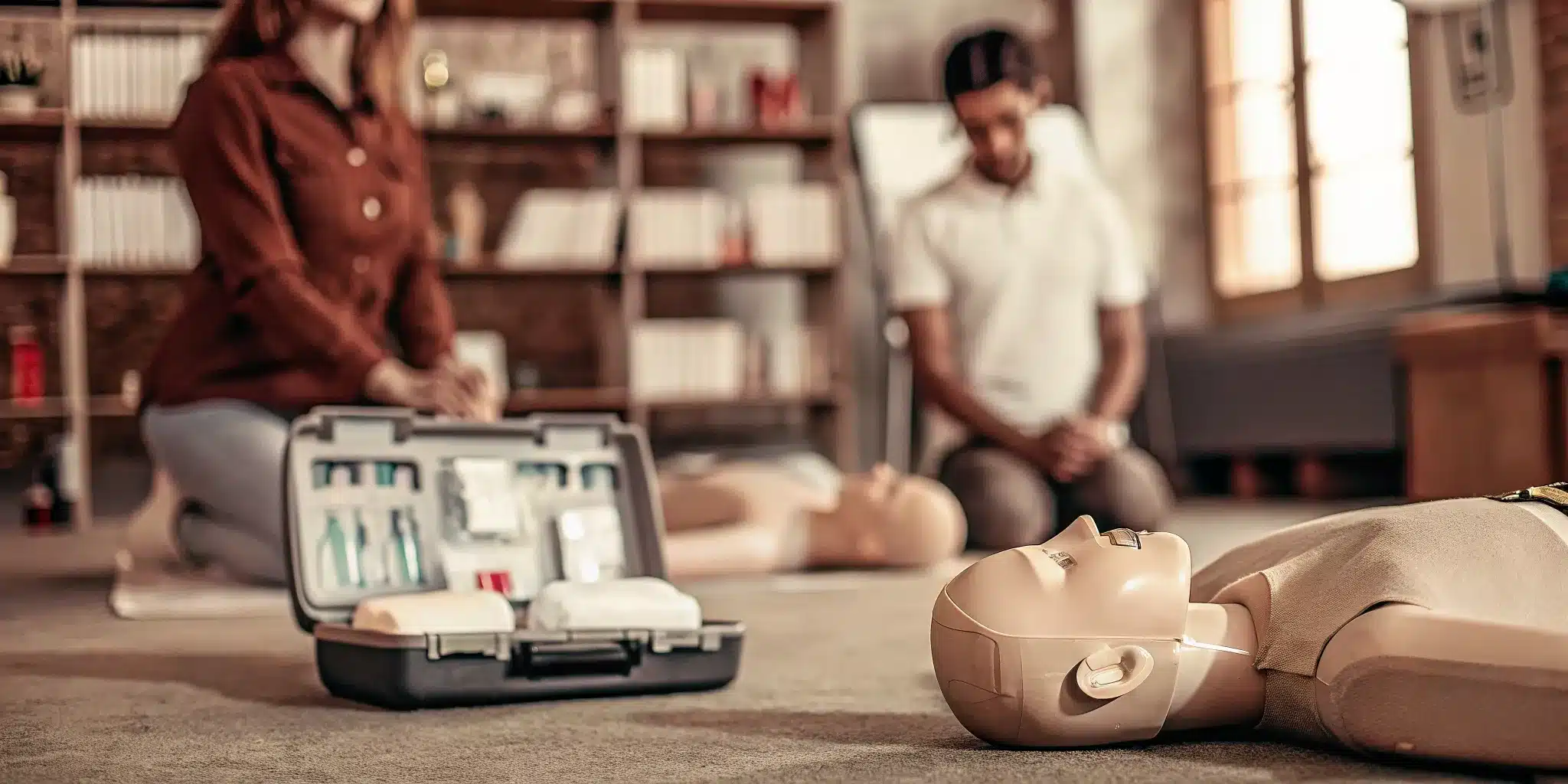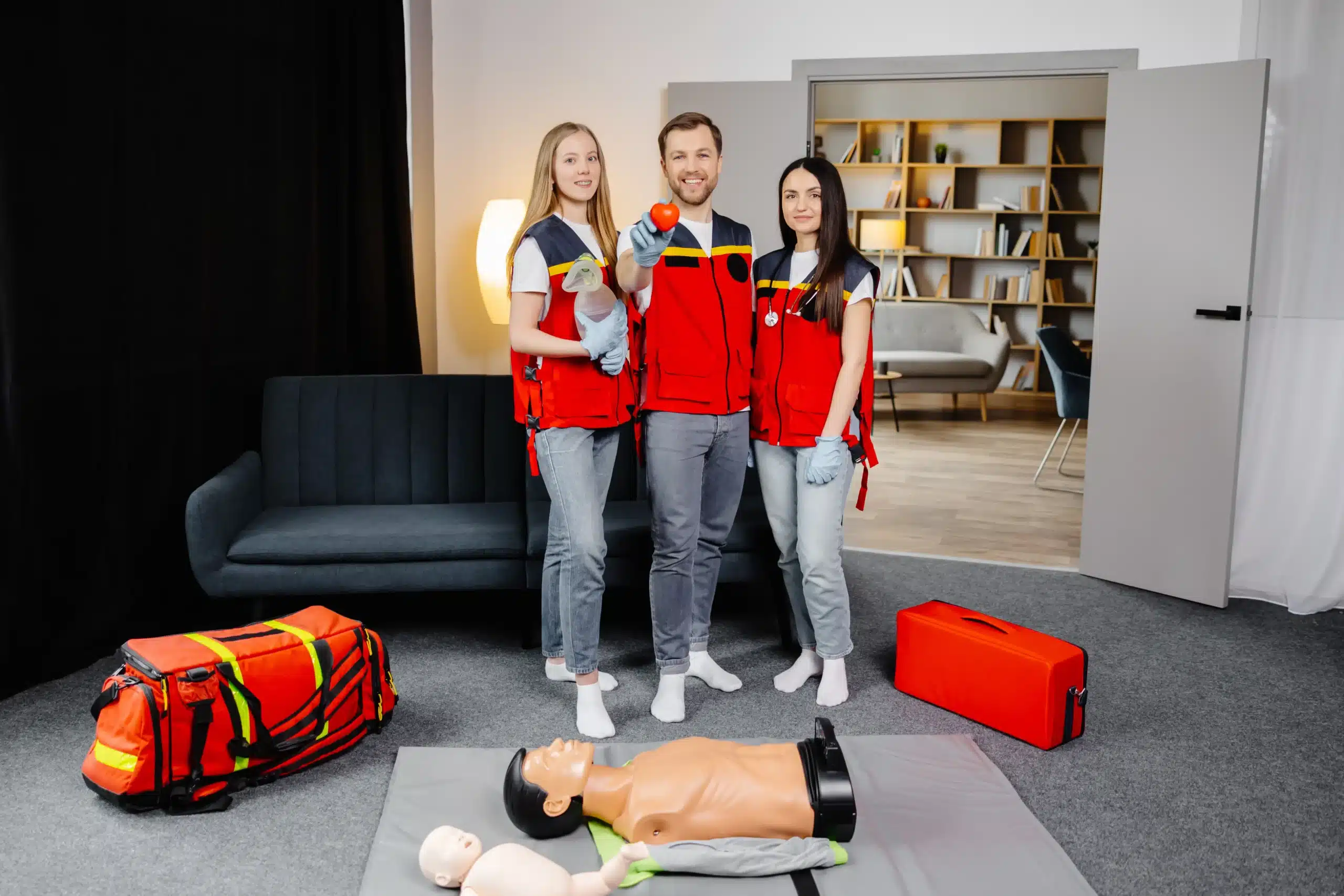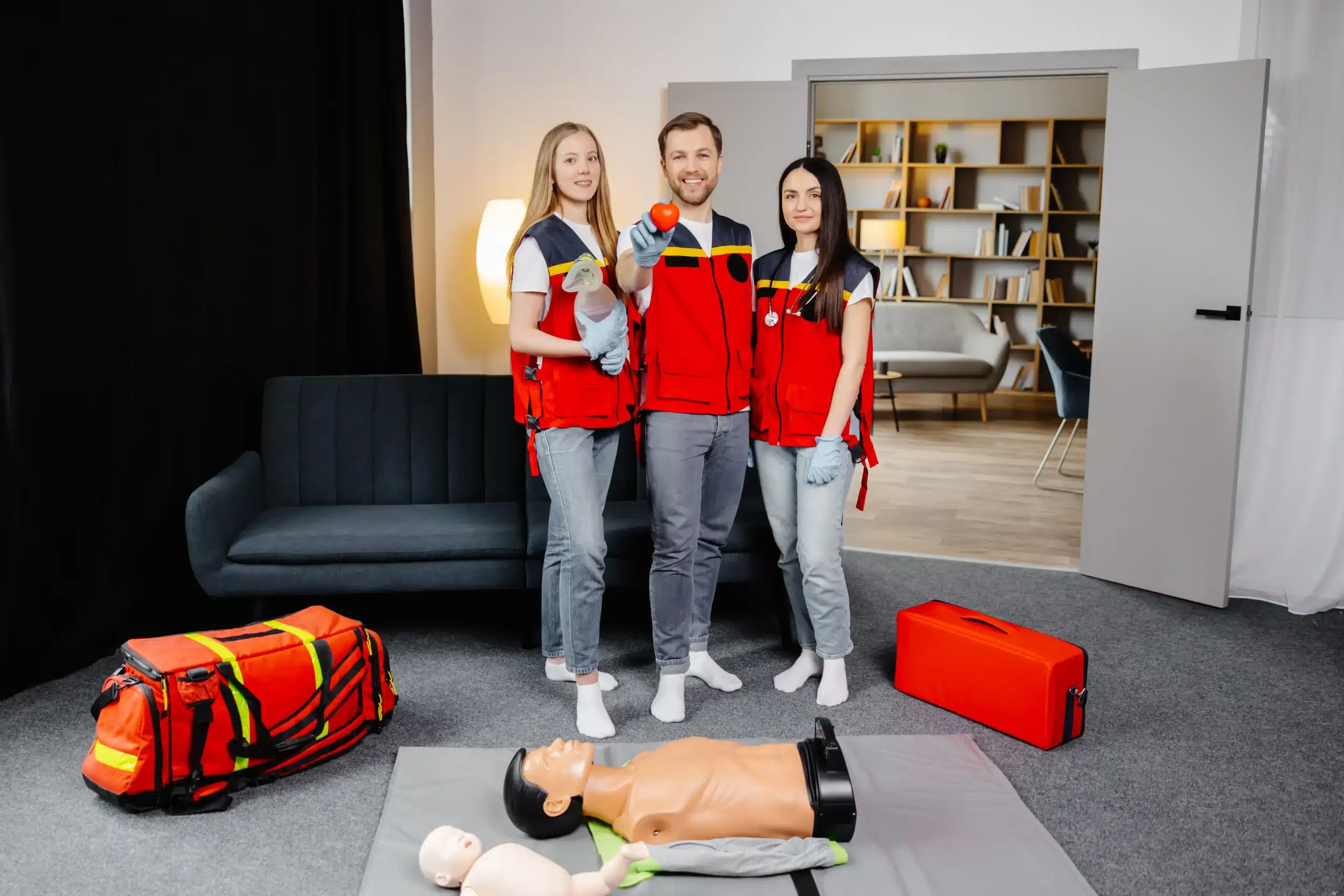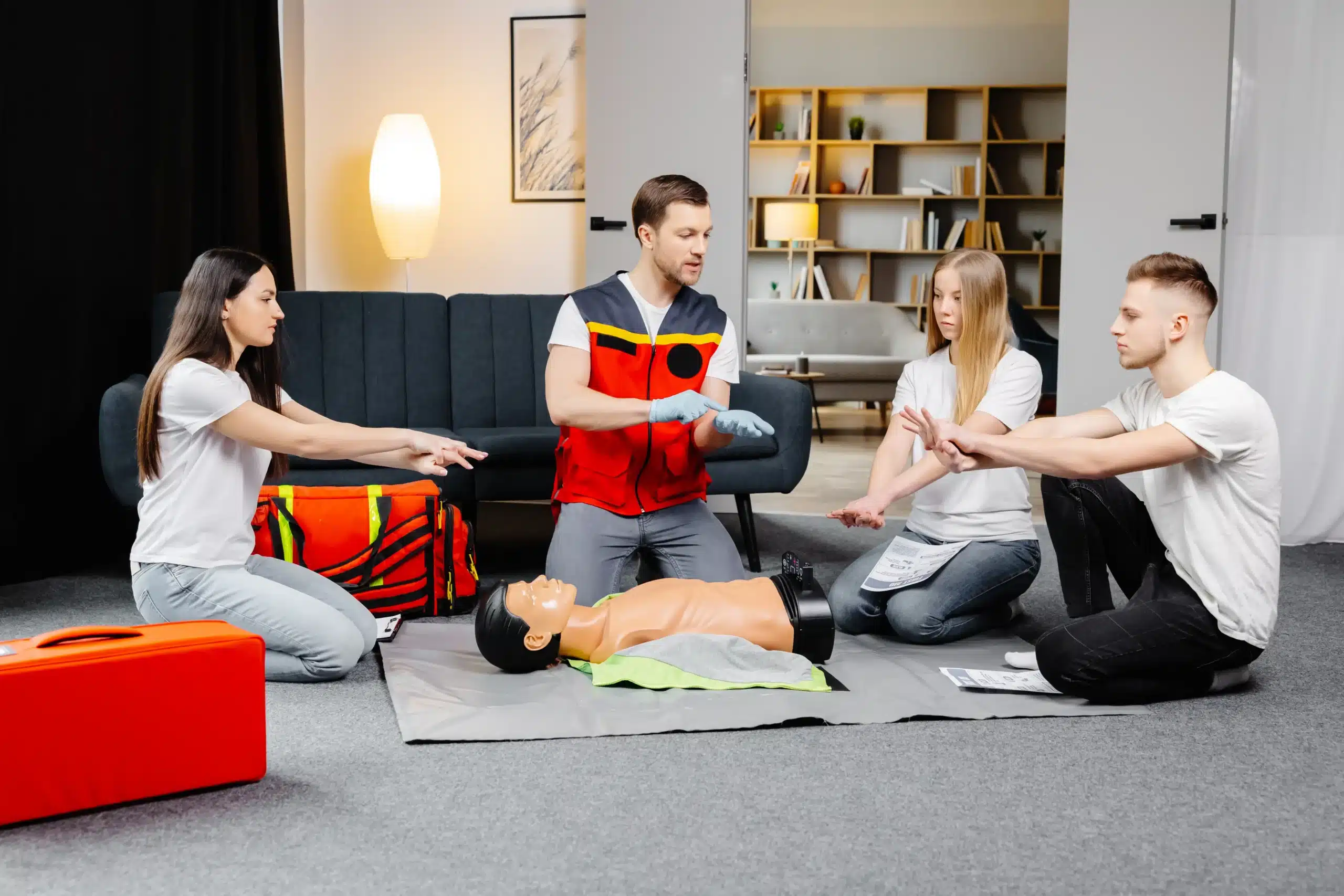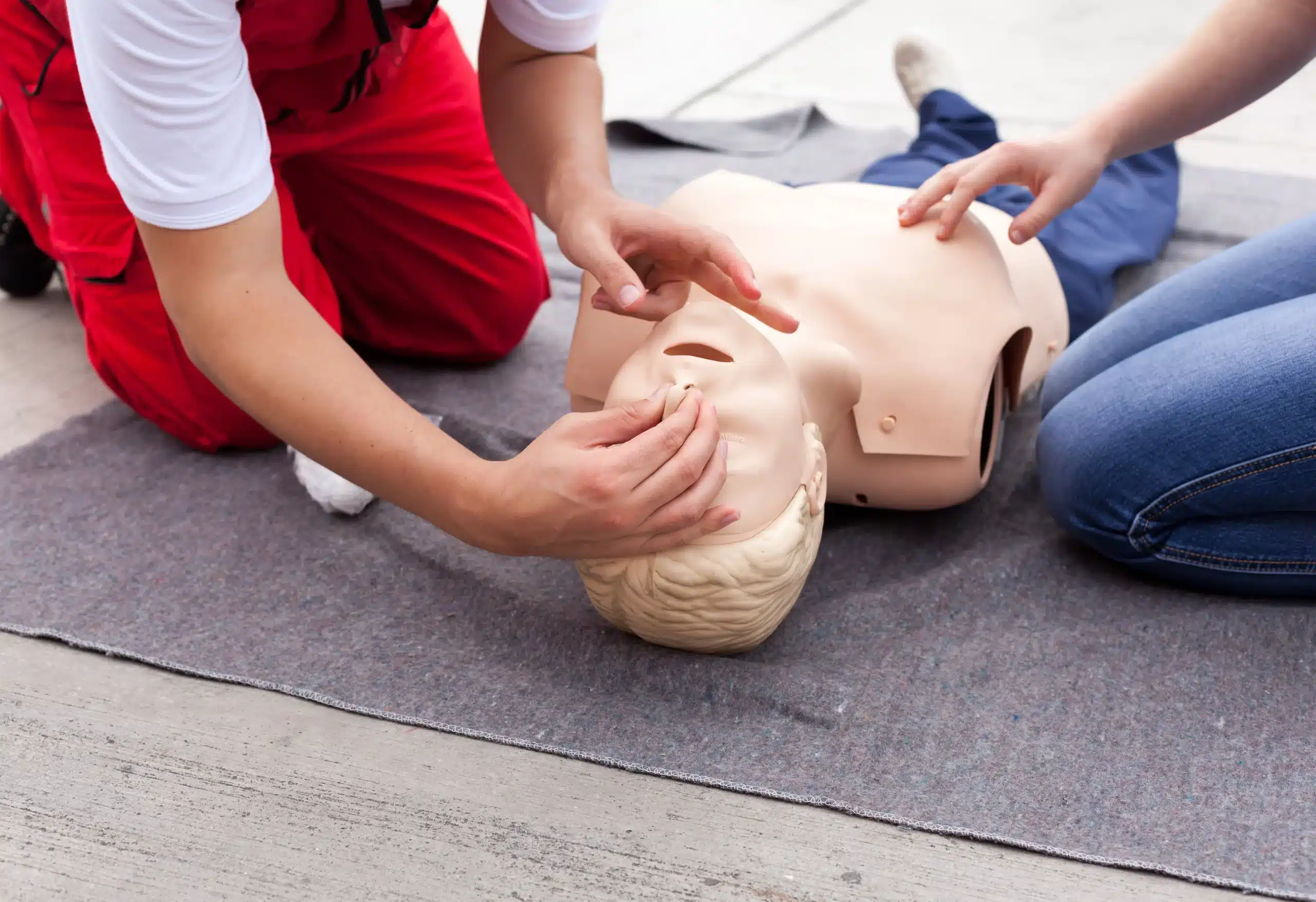Empower yourself with the knowledge and skills to make a difference in a medical emergency. First aid classes Napa provide comprehensive training that equips you to respond effectively in a crisis. This article is your comprehensive guide to first aid training in Napa, California. We’ll explore the different types of courses available, including CPR, BLS, ACLS, PALS, and specialized training for childcare providers. We’ll also discuss the costs and formats of first aid classes Napa, helping you find a course that fits your budget and schedule. Whether you’re a healthcare professional, a parent, a teacher, or simply a concerned citizen, this guide will help you find the perfect first aid training in Napa.
Key Takeaways
- Be prepared for emergencies with first aid training: Equipping yourself with life-saving skills through a Napa-based first aid course empowers you to confidently handle various medical situations, from minor injuries to critical emergencies.
- Napa offers a range of first aid courses: Explore the diverse options available in Napa, including CPR, BLS, ACLS, PALS, and specialized courses for childcare providers and workplaces. Choose a course that aligns with your specific needs and schedule.
- Maintain your first aid knowledge and skills: Keep your certification current, stay informed about the latest guidelines, and practice your skills regularly to ensure you can respond effectively in any emergency.
What are First Aid Classes in Napa?
First aid classes in Napa give you the skills to handle medical emergencies before professional help arrives. These courses cover various life-saving techniques, from treating minor injuries like cuts and burns to responding to more serious situations like choking or cardiac arrest. It’s like having a personal toolkit for unexpected health crises, empowering you to confidently provide immediate care when every second counts.
Napa offers a variety of first aid courses designed for different needs. The Napa CPR Training Center, in partnership with Napa Valley College, offers American Heart Association (AHA) certified courses for both healthcare professionals and the general public. If you need daily AHA certification courses, Safety Training Seminars provides training for CPR, Basic Life Support (BLS), Advanced Cardiovascular Life Support (ACLS), Pediatric Advanced Life Support (PALS), and standard First Aid. This flexibility makes it easy to find a class that works with your schedule and learning goals. Whether you’re a parent, teacher, or just want to be prepared, first aid training in Napa provides valuable, potentially life-saving skills.
First Aid Class Types
Knowing what kind of first aid training you need can feel overwhelming. This section breaks down the different types of first aid classes available in Napa, so you can find the right fit.
CPR and BLS
CPR (Cardiopulmonary Resuscitation) and BLS (Basic Life Support) are foundational life-saving skills. While often used interchangeably, BLS typically encompasses a broader range of skills, including CPR, recognizing and responding to life-threatening emergencies, using an AED, and relieving choking. Napa CPR Classes offers American Heart Association (AHA) certified courses in both CPR and BLS, suitable for everyone from healthcare professionals to community members. These certifications are often required for healthcare providers, teachers, and other professionals.
ACLS
ACLS (Advanced Cardiovascular Life Support) certification goes beyond the basics of CPR and BLS. ACLS training is designed for healthcare providers like physicians, nurses, and paramedics who manage cardiovascular emergencies. It covers complex algorithms for treating heart attacks, strokes, and other serious conditions. Safety Training Seminars offers daily AHA-certified ACLS courses in Napa.
PALS
PALS (Pediatric Advanced Life Support) focuses on the specific needs of infants and children facing medical emergencies. PALS certification is essential for healthcare providers working in pediatrics, emergency medicine, and intensive care units. Like ACLS, PALS courses cover advanced life-saving techniques tailored to young patients. Napa CPR Classes offers PALS training to equip healthcare professionals with these critical skills.
First Aid for Childcare Providers
Childcare providers have a unique responsibility to ensure the safety and well-being of the children in their care. Specialized first aid and CPR training for childcare providers covers common childhood injuries and illnesses, including choking, allergic reactions, and basic wound care. These courses empower caregivers to respond effectively in emergencies and maintain a safe environment.
Workplace First Aid
Every workplace should have trained personnel ready to respond to medical emergencies. Workplace first aid training covers essential skills like CPR, using an AED, controlling bleeding, and managing burns. Implementing a comprehensive first aid program demonstrates a commitment to employee safety and can significantly reduce the severity of workplace incidents. Regularly reviewing and updating your workplace first aid protocols is crucial.
Top Napa First Aid Class Providers
Finding the right first aid class starts with a reputable provider. Here are some of the top options for first aid and CPR training in Napa:
Safety Training Seminars
Safety Training Seminars, a woman-owned American Heart Association (AHA) Training Center, focuses on high-quality BLS, ACLS, PALS, CPR, and First Aid training in Napa, CA. Their commitment to excellent instruction ensures participants receive comprehensive training that meets AHA standards. They also offer EMSA Child Care Health and Safety training and RQI classes for healthcare professionals seeking to maintain their resuscitation skills. Learn more about their specific course offerings for BLS, ACLS, and PALS certifications.
Napa CPR Training Center
The Napa CPR Training Center, affiliated with Napa Valley College, is an AHA-certified training center offering a range of CPR and first aid courses. They cater to both healthcare professionals and the general public, broadening access to these essential, life-saving skills.
Napa CPR
Napa CPR provides AHA-certified CPR and first aid classes for healthcare providers and the community. Their courses accommodate different experience levels, making it easy for anyone to learn vital emergency response techniques.
American Red Cross
The American Red Cross offers a wide variety of first aid and CPR training courses. These programs equip individuals with the skills to handle emergencies effectively. Their well-respected and widely recognized training makes them a reliable choice.
Napa Valley College
Napa Valley College integrates first aid and CPR training into its health occupations programs. This hands-on training gives students practical experience with life-saving techniques, preparing them for real-world situations.
Costs and Formats
Knowing the different costs and formats for first aid classes helps you find the right fit for your budget and schedule. Let’s break down the options.
Price Ranges and Discounts
First aid class prices in Napa vary depending on the provider and the type of certification. You’ll find options ranging from budget-friendly community courses to premium, specialized training. It’s always a good idea to check directly with providers for the most up-to-date pricing and any available discounts. For example, Safety Training Seminars is known for its competitive pricing in Northern California. Often, group discounts are available, making it more affordable to train with friends or colleagues.
In-Person Classes
Many people prefer the hands-on learning experience of in-person classes. Safety Training Seminars offers daily American Heart Association (AHA) certification courses right here in Napa. These in-person courses cover essential life-saving skills, including CPR, BLS, ACLS, PALS, and First Aid. The benefit of this format is the direct interaction with instructors and the opportunity to practice skills in a real-time setting.
Online Courses
If your schedule is packed, online courses offer a flexible way to get certified. The RQI program, for example, provides a convenient online certification process. This format allows you to learn at your own pace and revisit materials as needed. It’s a great option for those who prefer self-directed learning or have limited availability for in-person sessions.
Blended Learning
Combining the best of both worlds, blended learning formats offer a mix of online coursework and in-person skills sessions. You can complete the theoretical part online at your convenience and then attend a hands-on session to practice your skills. This format is a great way to balance flexibility with the benefits of in-person instruction. Check with local providers like Napa CPR Classes to see if they offer blended learning options.
What Happens in a First Aid Class?
Curious about what to expect in a first aid class? Here’s a preview of what you’ll learn and how the training is structured.
Course Duration and Structure
First aid classes in Napa are designed to fit your schedule. Safety Training Seminars offers courses daily, from 8 am to 10 pm. You can choose from in-person training led by an instructor or a blended learning format that combines online coursework with hands-on practice. This flexibility makes it easier to find a class that works for you.
Skills Covered
First aid courses cover a range of essential life-saving skills. You’ll learn the basics of CPR, including how to perform chest compressions and rescue breaths. The curriculum also includes training on how to use an AED (automated external defibrillator). Beyond CPR, you’ll gain practical skills for handling common medical emergencies like cuts, burns, sprains, and choking. Programs like Basic First Aid provide training applicable to various workplace settings, equipping you to respond effectively in emergencies. These skills are valuable for employees, managers, and anyone who wants to be prepared to help.
Certification
Upon successful completion of your first aid class, you’ll receive an official American Heart Association (AHA) certification card. This certification is valid for two years and demonstrates your competence in providing first aid. Remember that maintaining your certification through recertification is important to stay up-to-date with the latest guidelines and best practices.
Benefits of First Aid Training
Knowing what to do in a medical emergency can make all the difference. First aid training equips you with the skills to respond effectively, potentially saving lives and minimizing harm. Whether you’re a healthcare professional, a parent, or simply someone who wants to be prepared, understanding the benefits of first aid training can motivate you to take a class at our Napa location.
Prepare for Emergencies
First aid is the initial care you give to someone who’s injured or sick before professional help arrives. It’s about stabilizing the situation and providing comfort. Imagine witnessing a car accident or having a loved one experience a sudden medical crisis. First aid training empowers you to take immediate action, potentially preventing a situation from worsening. The training helps you assess the scene, prioritize injuries, and deliver appropriate care until paramedics arrive. This quick response can be crucial in minimizing the impact of injuries and even saving lives. Learn more about the importance of first aid training and how it prepares individuals for various emergency situations.
Professional Development
First aid training isn’t just for personal use; it’s a valuable asset in many professional settings. Studies show that emotions can significantly impact decision-making, especially in high-pressure situations where first aid is needed. Having this training allows you to remain calm and focused, making better decisions under stress. For healthcare professionals in Napa, maintaining current certifications like BLS, ACLS, and PALS through programs like the American Heart Association RQI is essential for career advancement and providing the best possible patient care. You can find more information on our BLS, ACLS, and PALS certification courses on our website. Even in non-medical fields, first aid training demonstrates a commitment to safety and can enhance your professional profile. Explore the impact of emotions on decision-making in first aid scenarios to understand the professional advantages of this training.
Community Safety
First aid training benefits not only individuals but entire communities. When more people are trained, the community becomes better equipped to handle emergencies. Debunking common first aid myths is a key part of this training, ensuring that people rely on accurate information and avoid harmful practices. A well-informed community can respond more effectively to accidents and sudden illnesses, creating a safer environment for everyone. By investing in first aid training, you’re not just investing in yourself, but also contributing to the well-being of your community. Learn how to identify and debunk common first aid myths and misconceptions to ensure you’re providing safe and effective assistance.
Choose the Right First Aid Class
Finding the right first aid class is like finding the right pair of shoes—it needs to fit your specific needs. This section will walk you through the process of choosing the perfect fit for your first aid training.
Assess Your Needs
Before you start searching for classes, take a moment to think about why you want first aid training. Are you a healthcare professional needing to maintain your certification? A parent wanting to be prepared for childhood emergencies? Or maybe an employer looking to train your team? Identifying your specific needs—like learning CPR for infants or wilderness first aid—will help you narrow your search. Knowing the context where you might need to use these skills is crucial, as first aid is often the immediate care given before professional help arrives. For more information on the importance of context in first aid, check out this research on first aid training.
Compare Courses and Providers
Once you have a clearer picture of your needs, you can start comparing courses and providers. Look for reputable organizations like the American Red Cross or American Heart Association. Also, consider local providers like Safety Training Seminars, a woman-owned AHA Training Center offering a range of courses—from basic first aid and CPR to more advanced certifications like BLS, ACLS, and PALS—right here in Napa, CA. Having a variety of options lets you choose the course that best aligns with your goals. They also offer EMSA Child Care Health & Safety and RQI classes.
Read Reviews
Finally, don’t underestimate the power of reviews. Hearing from others who have taken the class can give you valuable insights. Look for comments about the instructor’s teaching style, the course content, and the overall learning experience. Positive feedback can give you confidence in your choice. You can find reviews to get a feel for different classes and instructors in Napa.
Prepare for Your First Aid Class
Getting ready for your first aid class doesn’t require a ton of prep, but a little planning goes a long way. Knowing what to expect and how to prepare can help you feel confident and ready to learn these life-saving skills.
Required Materials
Most first aid courses, including those for CPR certification, provide all the necessary training materials. This often includes manuals, bandages, and resuscitation equipment for practice. You’ll receive an official American Heart Association certification card valid for two years upon successful completion of the course. Double-check with your chosen provider to confirm if there’s anything specific you need to bring.
Pre-Course Study
While pre-course study isn’t usually mandatory for basic first aid and CPR classes, familiarizing yourself with the basics can be helpful. Resources like the American Heart Association website offer valuable information on CPR and first aid techniques. Remember, consistent practice is key to retaining these skills. Regularly refresh your knowledge and consider taking refresher courses to stay sharp.
What to Wear and Bring
Comfort is key! Wear loose, comfortable clothing that allows for a full range of motion. You’ll be practicing hands-on skills, so avoid restrictive clothing or anything that might get in the way. Bring a notebook and pen to jot down important notes and any questions you may have for your instructor. The trainers at Napa CPR Classes are practicing professionals who foster a supportive and interactive learning environment. Finally, be sure to review the cancellation policy beforehand—knowing the refund timelines can save you from unexpected fees. Safety Training Seminars has a clear cancellation policy available on their website.
First Aid Training Misconceptions
It’s easy to get confused about first aid best practices. Let’s clear up some common misconceptions about first aid training.
Good Samaritan Laws
One common misconception is that you can be sued if you provide first aid and something goes wrong. The truth is, Good Samaritan laws protect those who voluntarily offer assistance in emergencies. These laws encourage people to help without fearing legal repercussions. So if you’re hesitant to help because you’re worried about being held liable, remember that Good Samaritan laws have your back. For more information on California’s Good Samaritan laws, review the details outlined in the California Health and Safety Code.
Debunking Treatment Myths
Another prevalent myth is that applying butter, oil, or other household substances to a burn can soothe pain and promote healing. This is ineffective and can actually worsen the injury. The best course of action for a burn is to cool it with cool (not ice cold) running water and seek medical advice. The Mayo Clinic offers helpful guidelines on treating burns. Don’t rely on outdated home remedies—get informed and be prepared.
Who Benefits from Training?
Some people think first aid training is only for healthcare professionals. Not true! Everyone benefits from having these skills. Knowing how to respond in a crisis gives you confidence and helps you think clearly under pressure. Plus, having more people in a community trained in first aid improves overall safety and preparedness. Research suggests that emotions can significantly impact decision-making in emergencies, highlighting the importance of first aid training. Consider taking a first aid class to learn these valuable skills.
Maintain Your First Aid Skills
Once you’ve earned your first aid certification, commit to keeping your skills fresh. Knowing what to do—and having the confidence to act quickly—can make all the difference in an emergency. Here’s how to stay on top of your first aid game:
Recertification
First aid certifications, like CPR, typically expire every two years. Make sure you recertify before your current certification lapses. This ensures your skills are up-to-date and aligned with the latest guidelines. Think of it like renewing your driver’s license—it keeps your qualifications current. Recertification courses often offer a refresher on essential skills and cover any new developments in first aid practices.
Stay Updated
The world of first aid is constantly evolving, with new research and techniques emerging regularly. Stay informed about these advancements by subscribing to industry newsletters or following reputable organizations like the American Heart Association. Even small updates to your knowledge can significantly impact your effectiveness in a real-life emergency. This ongoing learning ensures you’re always prepared to provide the best possible care.
Keep Skills Sharp
Regular practice is key to maintaining muscle memory and confidence in your first aid abilities. Consider attending supplemental workshops or practicing with friends and family. Run through various scenarios, like how to respond to a choking incident or treat a burn. This hands-on practice will help you react calmly and efficiently under pressure. Just like any other skill, consistent practice is crucial for mastery. It reinforces what you’ve learned and helps you stay sharp and ready to respond effectively.
Related Articles
- CPR & First-aid Classes in Napa, CA – Napa CPR Classes
- BLS, ACLS, PALS, CPR & First-aid Classes in Napa, CA
- AHA ACLS Classes in Napa, CA – Napa CPR Classes
- PALS Classes in Napa, CA – Napa CPR Classes
- Essential Workplace CPR and First-Aid Training Guide
Frequently Asked Questions
What’s the difference between CPR and BLS?
CPR focuses specifically on chest compressions and rescue breaths for someone who’s stopped breathing or has no heartbeat. BLS builds upon CPR, adding skills like using an AED and managing choking. Think of CPR as a single tool, while BLS is a whole toolkit for handling life-threatening emergencies.
Which first aid certification is right for me?
It depends on your situation. If you’re a healthcare professional, ACLS or PALS might be required. For childcare providers, specialized training covering common childhood injuries and illnesses is essential. If you’re simply looking to be prepared for everyday emergencies, a standard first aid and CPR course is a great starting point. Think about where you’ll most likely use these skills – at home, at work, or in the community – to guide your decision.
How much do first aid classes in Napa cost?
Prices vary based on the provider, the type of certification, and the course format (in-person, online, or blended). Check with specific providers like Safety Training Seminars or Napa CPR Classes for their current pricing. Many offer discounts for groups, so ask about those if you’re training with friends or colleagues.
What should I expect during a first aid class?
Expect a mix of instruction and hands-on practice. You’ll learn essential skills like CPR, using an AED, bandaging wounds, and managing various medical emergencies. Instructors create a supportive environment where you can ask questions and practice your skills until you feel confident.
How do I maintain my first aid certification after completing a course?
Most certifications are valid for two years. You’ll need to recertify to stay current with the latest guidelines and best practices. Look for recertification courses offered by your original provider or other reputable organizations. Regularly practicing your skills and staying updated on any changes in first aid procedures will also help you maintain your competence.
This article was written for free by MEGA SEO.
